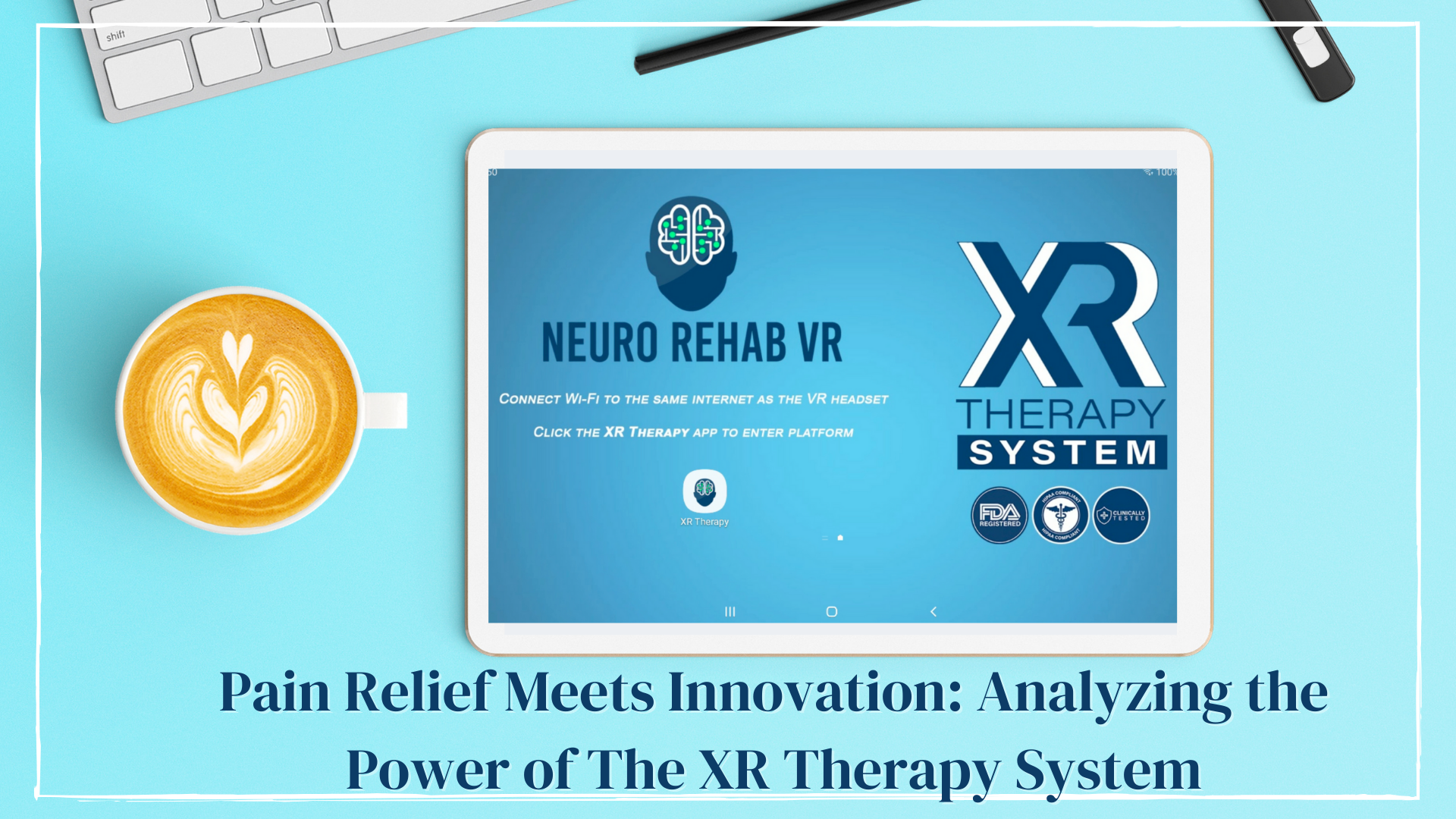Pain Relief Meets Innovation: Analyzing the Power of the XR Therapy
Written by: Brianna Hodge
Living with pain—whether chronic or temporary—can drain your energy, impact your mental health, and diminish your overall quality of life. If you’re someone who has experienced persistent pain, you likely understand how deeply it affects everything from your physical activities to your emotional well-being. While traditional therapies, medications, and lifestyle changes offer some relief, there’s a relatively new player on the scene that’s gaining momentum for its effectiveness: XR Therapy System.
XR Therapy System, which includes Virtual Reality (VR), and a use of AI, has been transforming the landscape of pain management. It not only helps alleviate physical discomfort but also offers an escape from the mental strain that pain often brings. Let’s dive deeper into how XR therapy works, its ability to elevate pain, and the remarkable sense of relaxation it offers.
Understanding the XR Therapy System for Pain Management
To truly appreciate how the XR Therapy System works for pain relief, let’s first break down what it is. Extended Reality refers to a combination of immersive technologies like VR and AR. In healthcare, VR is the most commonly used modality for pain management. When a patient wears a VR headset, they are transported into a virtual environment designed to engage their senses, distract them from pain, or even retrain their brain’s response to pain signals.
At first glance, it may seem like a futuristic concept—putting on a headset and suddenly feeling less pain—but the science behind XR therapy is well-researched. According to a study published in the Journal of Pain Research, VR therapy can decrease pain perception by up to 50%, showing promising potential for chronic pain sufferers (Jones et al., 2019). But how exactly does it work?
The Science of Distraction: Rewiring the Brain
Pain is both a physical and a psychological experience. Your brain constantly processes pain signals from your body, often amplifying those sensations when you focus on them. XR Therapy System taps into the brain’s neural pathways to essentially “distract” it from receiving and processing these pain signals.
When you immerse yourself in a VR environment, your brain is occupied by the rich stimuli around you—vivid landscapes, interactive elements, and soothing sounds. This multisensory experience reduces the attention your brain pays to pain, allowing it to calm down, essentially rewiring how it processes discomfort.
This phenomenon is backed by research, such as a 2021 study from Frontiers in Psychology, which suggests that VR experiences trigger a release of endorphins—our body’s natural painkillers—during and after a session. These neurochemicals work to elevate mood and diminish pain perception (Garcia et al., 2021).
Creating a Relaxing, Therapeutic Environment
Imagine this: you’re sitting on a beach, waves gently lapping at the shore, a warm breeze sweeping across your face. The sun begins to set, casting a soft orange glow across the water. This idyllic scene is often far from the stark, clinical settings many patients experience during traditional pain treatments. However, XR Therapy System can instantly transport you to this relaxing environment.
The ability to immerse yourself in calming, peaceful virtual spaces plays a significant role in the therapeutic potential of VR. Many of the programs for pain management incorporate tranquil environments like beaches, forests, or serene mountain trails, which help to relax the mind and reduce the body’s stress response. This is key for pain relief because stress and anxiety often exacerbate the perception of pain.
When your mind and body are in a relaxed state, the pain signals your brain receives are diminished, allowing for deeper relaxation and even prolonged relief. A study from Pain Management Nursing reveals that VR-based relaxation therapy significantly lowers levels of pain, anxiety, and discomfort in patients compared to traditional therapies (Spiegel et al., 2020).
VR Long-Term Benefits: Changing Your Pain Perception
One of the most intriguing aspects of XR Therapy System is how it can create lasting change in pain perception. The impact is not limited to the duration of the VR session itself. Over time, repeated use of VR can help reshape your brain’s response to chronic pain. For instance, exposure to VR-based cognitive behavioral therapy (CBT) can teach patients how to self-manage their pain through mindfulness and relaxation techniques.
Let’s take chronic lower back pain as an example. Many patients report a cycle of pain, stress, and reduced mobility.It breaks that cycle by helping patients refocus their attention away from the pain and onto movements, mental exercises, or calming visuals, promoting positive feedback loops within the brain. Over time, this reduced focus on pain trains the brain to be less reactive to pain signals.
A Complementary Tool, Not a Replacement
It’s important to recognize that the XR Therapy System is not a cure-all or a replacement for traditional pain management strategies. Medications, physical therapy, and other treatments still play a critical role, depending on your condition. However, VR can serve as an effective complementary tool, especially for those who may be looking to reduce their reliance on opioids or other strong medications.
In fact, several healthcare systems are already adopting XR Therapy System as part of a holistic pain management plan. Major hospitals, rehabilitation centers, and clinics have begun integrating these technologies to offer patients a well-rounded approach to treatment. By combining VR with physical therapy and other forms of rehabilitation, patients often experience faster recovery times and enhanced quality of life.
The Emotional and Psychological Benefits of The XR Therapy System
Beyond physical pain relief, the system offers significant emotional and psychological benefits. Chronic pain is closely linked to anxiety, depression, and feelings of hopelessness. Living in a constant state of discomfort can wear down even the most resilient individuals, and traditional methods may not always address the emotional toll pain takes.
The XR Therapy System helps to alleviate this burden by offering moments of escapism—taking you out of your pain and into a world where you can focus on something other than discomfort. Whether you’re exploring a vibrant digital landscape, solving puzzles, or simply taking a virtual walk through a tranquil forest, the ability to mentally “escape” creates a powerful psychological lift.
For some, this sense of relief may be temporary, but for others, it can act as a crucial part of emotional healing. Studies have shown that patients who use VR report improved mood, lower levels of stress, and a greater sense of control over their pain management journey (Garcia et al., 2021).
Your Experience with VR
Although VR is still emerging in mainstream therapy, its application is growing quickly. Whether your patient is dealing with post-surgical pain, chronic pain from conditions like fibromyalgia or arthritis, or even pain related to cancer treatment, the XR Therapy System offers the relief and relaxation that may lead to better patient outcomes.
Ultimately, it offers a new dimension to pain management—one that empowers you to actively follow your patient treatments in real time. The ability to not only elevate physical pain but also provide emotional relief makes it a truly groundbreaking tool in modern medicine.
-
Garcia, L. M., et al. “Virtual Reality for Pain Management: Current Trends and Future Directions.” Frontiers in Psychology, vol. 12, 2021, doi:10.3389/fpsyg.2021.628314.
Jones, T., et al. “Virtual Reality for Chronic Pain Relief: A Literature Review.” Journal of Pain Research, vol. 12, 2019, pp. 2053-2065, doi:10.2147/JPR.S189902.
Spiegel, B., et al. “VR-based Relaxation Therapy for Pain Management in Hospitalized Patients.” Pain Management Nursing, vol. 21, no. 2, 2020, pp. 123-129, doi:10.1016/j.pmn.2019.07.007.






